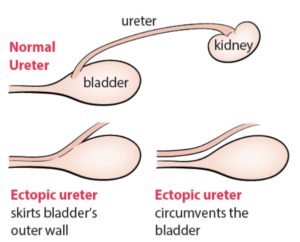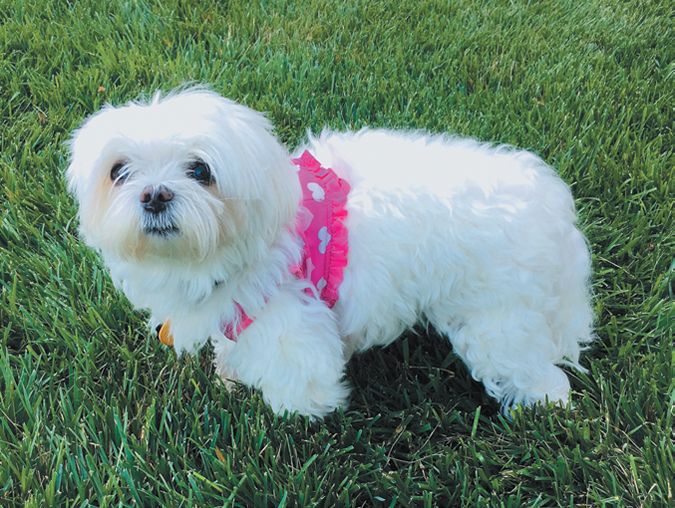ectopic [ek’täpik] adjective (medicine): in an abnormal place or position.
■ Your puppy is now close to a year old, but she is still frequently dribbling urine inside the house. Or she keeps getting urinary tract infections (UTIs). What could be going on?
There is a reasonable chance that one or both of her ureters is ectopic. Normally, the ureters carry urine from the kidneys to the bladder. From there, when enough urine collects, the urine makes it way to the urethra and then out through the vagina or penis. But a ureter that is ectopic, which is the medical term for “misplaced,” doesn’t empty into the bladder as it should. It circumvents that organ and terminates in the urethra or vagina instead. Or, more commonly, it enters the bladder’s outer wall but does not actually enter the bladder and instead travels within the wall to the wrong locations. Either way, urine storage is not occurring as it should; the bladder normally functions as a urine holding tank, but it is being bypassed. Thus, dribbling occurs. UTIs become more common, too, because misaligned urinary parts allow for infiltration of harmful bacteria.
The condition, a birth defect, is much more common in females. And it’s much more common in certain breeds, including Labrador retrievers, golden retrievers, Siberian huskies, Newfoundlands, and West Highland white terriers. But it can strike any dog. And it strikes with a certain frequency. “We probably see about one or two cases a month,” says John Berg, DVM, a surgeon at Tufts’ Foster Hospital for Small Animals and the editor-in-chief of Your Dog. In at least a third of all cases, both ureters are affected.
Owners usually bring their dogs in when they’re close to a year of age because before that, they just assume their puppy hasn’t yet gotten the hang of toileting outside. Or it’s at around one year that they’re noticing more signs of UTIs — straining to urinate and licking around the vulva where urine exits.
Making a diagnosis
Urine dribbling may result from a number of things other than an ectopic ureter, such as a weak bladder sphincter muscle that makes it hard for the bladder to hold urine and, in female dogs, a deep skin fold over the vagina that is not supposed to be there. It’s called a recessed vulva, and infection within the skin fold leads to chronic UTIs, which can cause dribbling.
For a proper diagnosis, a veterinarian will conduct one or more imaging studies. One possibility is an ultrasound. When urine squirts into the bladder from the ureters, an ultrasound will pick it up. If the visible squirting is missing from one or both ureters, “that makes us suspicious of ectopic ureters,” Dr. Berg says. A dilated ureter is another possible ultrasound sign, he says. Urine may not easily flow out of the abnormal termination of the ureter, and the back-pressure causes the ureter to expand.
Imaging tests that can detect an ectopic ureter with even more certainty are x-rays or CT scans that use dyes to make the ureter easy to visualize.
Treatment options
If the ureter enters the wall of the bladder and tunnels down to the urethra without actually emptying into the bladder itself, it can be treated with a laser. The laser cuts the wall of tissue separating the ureter and urethra, and the doctor lasers high enough up to create a direct opening between the ureter and the bladder cavity. That way, urine can empty from the ureter directly into the bladder rather than bypass it.
But if the ureter misses the bladder completely, it requires a surgical fix. “We make an incision in the abdomen,” Dr. Berg says. “Then we cut the ureter, make a little opening in the bladder, and place the ureter there with sutures. If both ureters are ectopic, we repair each ureter during the same procedure.”
Prognosis
While virtually all dogs who undergo a procedure to correct an ectopic ureter experience improvements in continence, an estimated half of them still experience some degree of urine dribbling. “It’s not completely clear why,” Dr. Berg says. One theory is that poor bladder sphincter tone may be present in dogs with ectopic ureters, allowing urine to leak even if the ureters have been repaired. Also, notes Dr. Berg, because the bladder never had much urine in it, “it kind of shrivels up and may not have the capacity of a normal bladder.”
The good news is that medications that tighten the bladder sphincter muscle can often help resolve any residual problem. And even if it the dribbling can’t be completely resolved, it will usually be nowhere near as problematic as before.

Imagine the dog’s head to the right, the tail to the left. (The view is from the side.) In the top illustration, the ureter travels from the kidney directly to the bladder, where it deposits urine. (There are actually two kidneys and two ureters emptying into a single bladder; we’ve “abbreviated” for clarity.) When a ureter is ectopic, on the other hand, you get either the scenario at the bottom, left, where the ureter only skirts the bladder’s outer wall, or the one at the bottom right, where it circumvents the bladder completely. Since the bladder is urine’s “holding tank” but is being missed, dribbling occurs.





